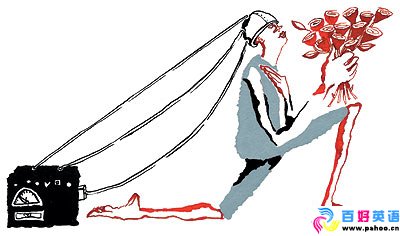
Scientists are finding that, after all, love really is down to a chemical addiction between people
科学家们发现爱情确实是人与人之间的一种化学成瘾现象。
OVER the course of history it has been artists, poets and playwrights who have made the GREatest progress in humanity's understanding of love. Romance has seemed as inexplicable as the beauty of a rainbow. But these days scientists are challenging that notion, and they have rather a lot to say about how and why people love each other.
在漫长的历史长河中,艺术家、诗人和剧作家在人类对于爱的理解上做出了巨大成就。古往今来,爱的浪漫被视为霓虹,美得难以言状。而最近,科学家们却向这种观念发出了挑战,并且对恋人们如何与为什么相爱做出许多新的解释。
Is this useful? The scientists think so. For a start, understanding the neurochemical pathways that regulate social attachments may help to deal with defects in people's ability to form relationships. All relationships, whether they are those of parents with their children, spouses with their partners, or workers with their colleagues, rely on an ability to create and maintain social ties. Defects can be disabling, and become apparent as disorders such as autism and schizophrenia—and, indeed, as the serious depression that can result from rejection in love. Research is also shedding light on some of the more extreme forms of sexual behaviour. And, controversially, some utopian fringe groups see such work as the doorway to a future where love is guaranteed because it will be provided chemically, or even genetically engineered from conception.
这真的有用吗?科学家们确实如是考虑。首先,让我们先来了解一下可调节社会附属关系的神经化学路径, 这有助于我们解决某些缺乏建立人际能力人群的问题。对于所有关系而言——无论是父母与子女间的亲情关系、夫妻间的婚姻关系,还是同事间的伙伴关系,全都依赖于一种建立并保持社会性纽带的能力。这种能力的缺损可使个人丧失行为能力并导致明显的心理紊乱,如自闭症和精神分裂症,正如将恋爱拒之门外可导致严重的沮丧一样。研究者们同样把目光投向了若干形式更为极端的性行为。有争议的是, 一些理想化且处于前沿领域的团体视该项工作为通向未来的一道大门。那时爱情将不会有任何风险,因为源于这个概念的化学或基因工程便可能将其变为现实。
The scientific tale of love begins innocently enough, with voles. The prairie vole is a sociable creature, one of the only 3% of mammal species that appear to form monogamous relationships. Mating between prairie voles is a tremendous 24-hour effort. After this, they bond for life. They prefer to spend time with each other, groom each other for hours on end and nest together. They avoid meeting other potential mates. The male becomes an agGREssive guard of the female. And when their pups are born, they become affectionate and attentive parents. However, another vole, a close relative called the montane vole, has no interest in partnership beyond one-night-stand sex. What is intriguing is that these vast differences in behaviour are the result of a mere handful of genes. The two vole species are more than 99% alike, genetically.
关于爱情的科学传说非常无辜地始于田鼠。草原田鼠作为一种社会性生物,它是仅存3%的“一夫一妻制”哺乳动物中的一类。对“恋爱”中的草原田鼠来说,交配是一项耗时24小时的宏伟工程。一旦“结婚”,小俩口便终生相伴,直到天荒地老。“夫妻俩”宁愿在一起共度时光,为彼此梳理毛发,同筑爱巢也不去搞“婚外恋”。平时,“丈夫”是“妻子”好斗的“护花使者”,而幼崽一旦出生,它们又即刻成为挚爱并专一的父母。然而,另一种被称作山区田鼠的,作为草原田鼠近亲,除了一夜情之外,它们对稳定的伴侣关系毫无兴趣。令人不解的是这些行为中的巨大差异却仅仅源于一小撮基因。如就基因而言,这两个物种超过99%的部分绝无二致。


